Asclepias viridiflora, Green Comet Milkweed or Green Milkweed, is a native perennial herbaceous plant that blooms in the summer. In NJ, it is on the list of 'Endangered Plant Species and Plant Species of Concern' 2022.
Flowers
Inflorescence/Flower cluster:
One to four big flower clusters emerge at the top of the stem from the axils of the upper leaves. The nodding dense hemispherical shaped clusters are about 2 inches across with many flowers. All the flowers in the cluster originate from a single point and the cluster is called an umbel. Only one umbel forms at an axil of a pair of leaves.
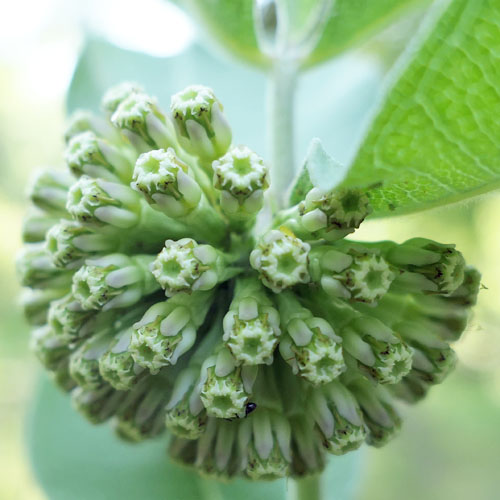
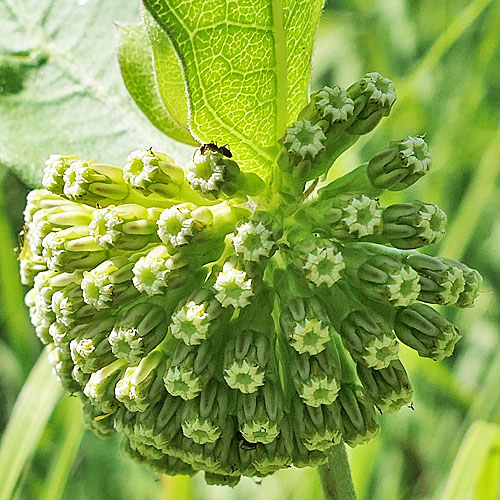
Individual Flower:
These non-showy flowers are pale green and are about 1/4 inch across and 1/2 inch deep. It exhibits the usual milkweed structure but with one omission - it does not have horns.
Milkweed flower structure & Asclepias viridiflora, green comet milkweed:
Actually, all the milkweeds have similar structure. The flower has both male and female parts. The flower has 5 petals and 5 sepals.
Diagram of a general milkweed flower:
- hn: horn Note: Green Comet Milkweed does not have horns!
- cp: corpusculum
- ss: stigmatic slit
- hd: hood
- pt: petal, reflexed
- cp: corpusculum
- ta: translator arm
- ps: pollinia (pollen sac)

Internet Archive Book Images, No restrictions, via Wikimedia Commons
The green petals are folded back tight against the flower stalk.
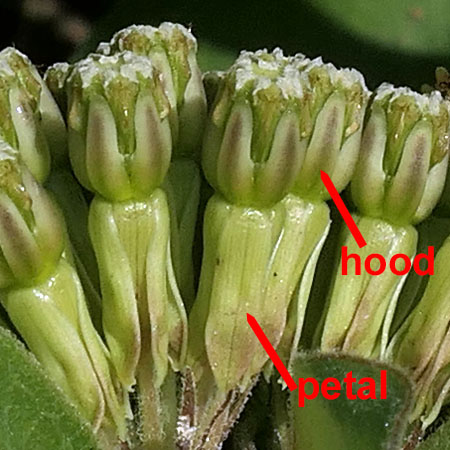
The sepals are not easy to see when the flowers are open. At the bud stage, the sepals can be seen and they are pale green and just a few mm's long and hairy.
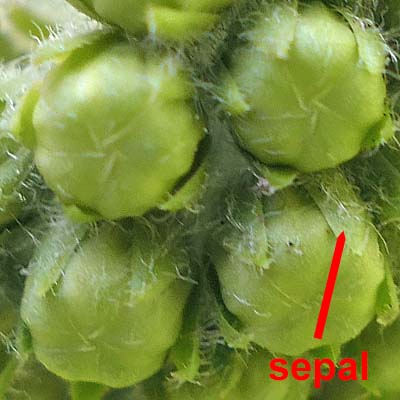
Inside/above the petals is a circle of 5 hoods. The hoods hold a plentiful supply of nectar which attracts insects. Note that green comet milkweed does not have horns, which is unusual! These hoods encircle the gynostegium. The gynostegium (whitish part in the center) is a column of partially fused stamens and the pistil (male & female parts).
There are 5 stamens. The anthers, surrounding the outside of the gynostegium, are divided in half giving 10 anther pouches, with a slit between each anther pouch. The slit is called the stigmatic slit.
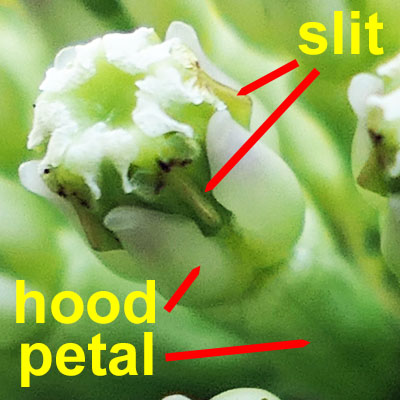
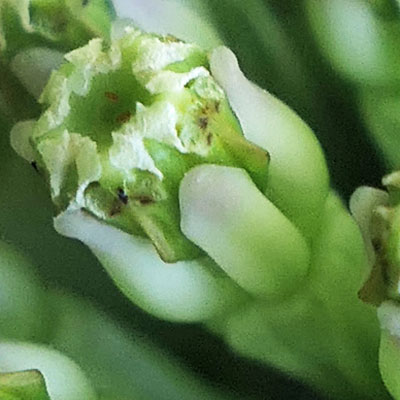
Instead of individual pollen grains, the grains are together in a sac (pollen sac) called the pollinium (pollinia - plural). There is a pollinia(pollen sac) inside of each anther pouch. The pollinia (anther sacs) are connected to the corpusculum which is the dark object outside at the top of the slit. The translator arms connect the corpusculum(dark object) to the pollinia(pollen sacs). These three parts, corpusculum, translator arm & pollinia, together are called a pollinarium. See diagram above.
Now for the female parts: In the gynostegium are 5 receptive stigmatic surfaces that are inside of 5 stigmatic chambers. Access to the receptive stigmatic surfaces is only through the stigmatic slits. Interestingly, each flower has two ovaries. Two stigmatic chambers are connected to one ovary and 3 stigmatic chambers are connected to the other ovary.
Here are some close up of the slit and the corpusculum (dark spot).
In the last of the 3 photos below, a pollinarium was left on top of the flower showing the dark spot, the brown arms, and the pale yellow pollen sac.
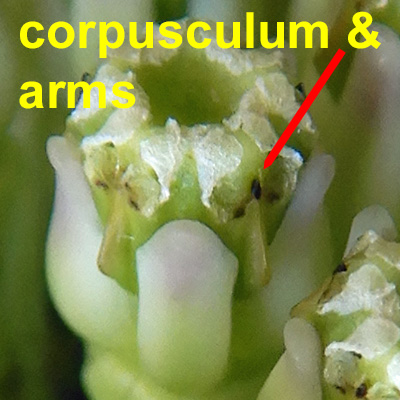
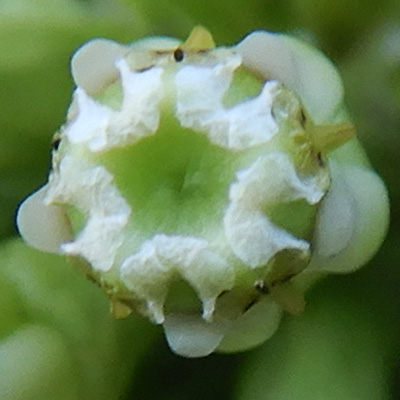
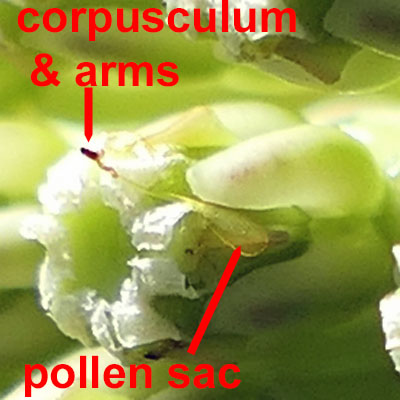
Pollination
Pollinating insects must be compatible with the specialized flower structure of milkweeds. A bee/pollinator's leg would slip into a stigmatic slit and on exiting, the leg would catch the dark spot (corpusculum). The corpusculum adheres to the leg and when the leg moves out, the corpusculum pulls the pollen sacs out of the anther pouches by the translator arms. The insect goes to another plant, and somehow inserts the pollen sac into the stigmatic slit into the stigmatic chamber! This interesting pollination process is described in more detail in the Asclepias syriaca, common milkweed page with references: click here.
Fruit
The green milkweed seed pods (follicles) are up to about 4 inches long, wider at the base and coming to a point at the tip. They are smooth or short hairy.
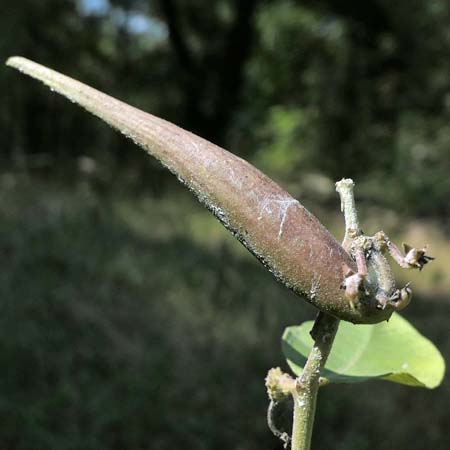
Plant - Leaves - Habitat
The green comet milkweed plant is a large upright perennial growing to 3 feet tall and at the top usually one or two flower umbels form. The stem is pale green and short-pubescent. The root system of green milkweed consists mainly of a stout fleshy taproot. The leaves are short petiolate (short-stalked) and opposite or almost opposite.
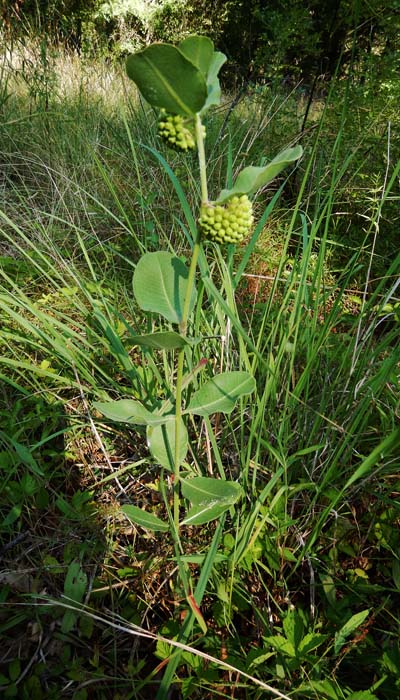
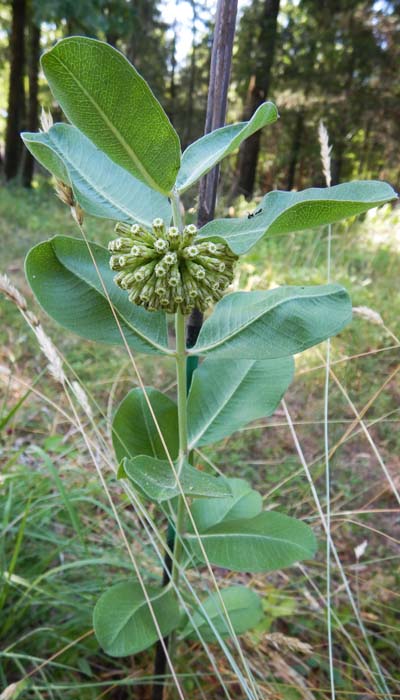
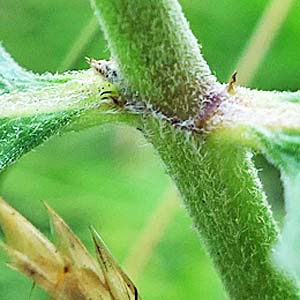
The leaves are simple, opposite or nearly opposite and paired but not whorled. The margins are smooth and sometimes wavy. The leaves are frequently not flat but wavy. The leaf stalks (petioles) are short.
The leaf shapes can be somewhat variable from narrower to wider. The leaves are somewhat coarse. They are in general elliptic-oblong (wider in the middle and rectangular with rounded ends). The leaves are about 4 inches long and 2 inches wide.
The leaf has a prominent midrib. The many smaller veins extending from the midrib to almost the edge have a distinctive pattern with the veins almost parallel to each other and perpendicular to the midrib.
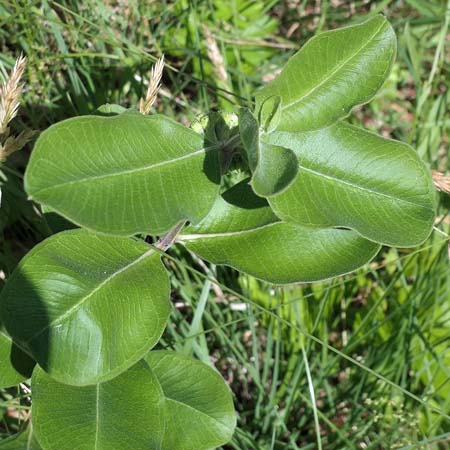
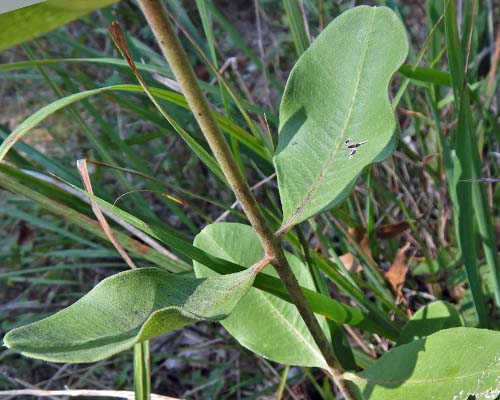
Leaf upper surface is hairy.
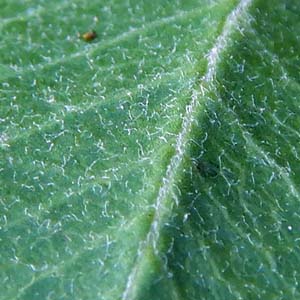
Leaf lower surface is also hairy.
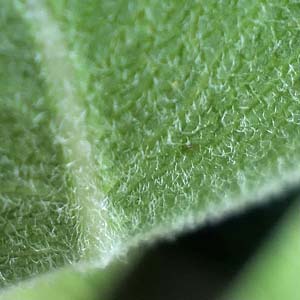
Like other milkweeds, when the leaves or stems of green milkweed are broken, they produce a milky latex. This liquid contain various levels of toxic cardiac glycoside compounds which makes the plants toxic to most insects and animals but not deer.
Rarity: In New Jersey Asclepias viridiflora is S2 (Imperiled) 2022 but globally secure G5.
Text by Millie Ling and all photos by Hubert & Millie Ling. Photos: Flowers - July 11, 2022, Hunterdon County, NJ.
Additional information
Additional information / references:
- Illinois Wildflowers
https://www.illinoiswildflowers.info/prairie/plantx/sg_milkweedx.htm - The Intricate Dance of Milkweed Pollination: has a good drawing
https://www.hachettebookgroup.com/articles/the-intricate-dance-of-milkweed-pollination/ - USDA Milkweed Pollination Biology: excellent description
https://www.nrcs.usda.gov/Internet/FSE_PLANTMATERIALS/publications/nvpmctn12764.pdf - Lady Bird Johnson Wildflower Center
"Leaves are variable in shape with plants from dry sites having long narrow leaves and those from moist sites having round leaves."
https://www.wildflower.org/plants/result.php?id_plant=ASVI - Missouri Plants
https://www.missouriplants.com/Asclepias_viridiflora_page.html - The USDA website shows Asclepias viridiflora nativity in the US down to county level and other information: https://plants.usda.gov/home/plantProfile?symbol=ASVI
- NatureServe - rarity & distribution. https://explorer.natureserve.org/Taxon/ELEMENT_GLOBAL.2.156640/Asclepias_viridiflora
- Key to NJ Milkweeds, New England has almost the same milkweeds as NJ: GoBotany. https://gobotany.nativeplanttrust.org/dkey/asclepias/#all